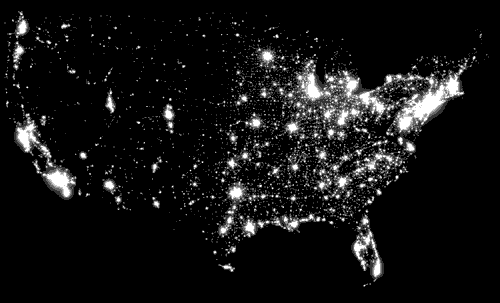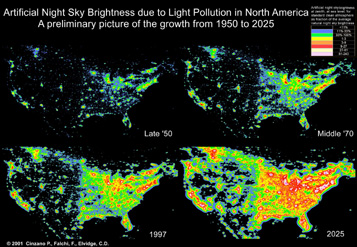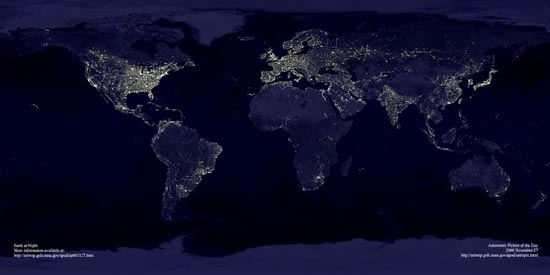Sierra Nature Notes, Volume 3, December 2003
Starry, Starry Night
A Thing of the Past?
Judy Rocchio NPS Pacific West Region, Air Quality
Tamara Williams Golden Gate National Recreation Area, Natural Resources
Dan Duriscoe Physical Scientist, Night Sky Project, Death
Valley National Park
 |
| The United States at Night: The increasing glare of lights make the stars impossible to see in much of the country. |
The stars
awaken a certain reverence, because though always present, they are inaccessible.
Ralph Waldo Emerson
The stars of the Milky Way have fascinated humans for millennia. Ancient mariners guided everything from outriggers to sailing ships using this galactic road map. But it is quite possible that future generations of children will not be able to see the galaxy they live in, or the wondrous canopy of stars that has inspired poets, philosophers, and dreamers for centuries. The flood of artificial light that washes the stars from the sky today has left one in five human beings unable to see the Milky Way at night, according to a new study of the global effects of light pollution.
A 2001 global satellite study conducted by scientists at the University of Padua, Italy, and the U.S. National Oceanic and Atmospheric Administration (NOAA) measured for the first time how light degrades the view of stars in specific places around the globe.
"The rapid increase in light pollution is one of the most dramatic changes occurring in our natural environment," noted the Royal Astronomical Society, which published the study. The survey shows that truly dark, starry skies are unavailable to two-thirds of the world's population, including 99 percent of people in the continental United States and Western Europe. The report describes regions of the world where true night never occurs because it is blocked by lights from cities and towns. In night's darkest places, far from city lights, about 2,000 stars are typically visible. In major cities, that number shrinks to a few dozen at most.
 |
| Artificial
Night Sky Brightness due to Light Pollution: 1950 to 2025. Today, two
thirds of the USA's population have lost naked eye visibility of the
Milky Way. Click
to Enlarge to full explanation. Copyright © Night Sky in the World |
Darkness as a Wilderness Value
In the last 30 years, backcountry rangers in Yosemite and Sequoia and
Kings Canyon National Parks have stood on vantage points high on the west
slope of the Sierra and looked west into California's Central Valley.
Over that time, they have watched as small islands of light have grown
into one continuous and glaring
river
stretching from Sacramento to Bakersfield. There
is so much artificial light today that, on a clear night, stars in the
west are noticeably dimmed compared to the view east. In places, the
Milky Way is not even visible.
“The glow from the cities is light pollution, and it cuts the number of visible stars here in half, from about 15,000 to 7,000,” said Chad Moore, a physical scientist at Pinnacles National Monument. Moore sees darkness as an important resource in need of protection.
“Can you imagine how much art, literature, poetry, draws inspiration from night skies?" said Moore, who is one of the first people to scientifically measure the glow. "To lose that is to lose a pretty significant cultural resource.”
Part of the intent of the Wilderness Act of 1964 was to provide all Americans access to “primitive and unconfined” recreation and opportunities for the spiritual enlightenment and personal development such experiences provide. The view of a dark night sky can certainly be interpreted as an integral part of that experience, and remote wilderness parks are among the few places left where it can be seen.
If an artificial light is erected and maintained that compromises or interferes with the view of the night sky from a wilderness preserve, that light is in violation of one of the basic premises of the wilderness ethic: namely, obvious evidence of human technology becomes visible on the landscape. Such a situation is known as “light trespass,” and may be regarded as just as serious a violation of the wilderness character as the trespass of domestic livestock or off-highway vehicles onto wilderness lands.
Exactly what is lost when the view of the night sky is less than pristine? Astronomers, professional and amateur, have addressed this question from a technical or scientific standpoint for at least three decades. An increase in sky brightness leads to a decrease in contrast between faint or diffuse astronomical objects and the sky background, in many cases rendering them invisible. Many of the more sublime features of the night sky are subtle or diffuse in nature, such as the zodiacal light and the Milky Way. A glow near the horizon from distant cities or towns, while not significantly affecting the sky quality near the zenith, may cause a “light dome” to become silhouetted against the horizon and foreground objects in the direction of the city, washing out stars and other astronomical objects. This leads to a significant degradation of the wild appearance of the landscape for the nighttime wilderness visitor. An unbroken carpet of stars extending nearly to the horizon in all directions with no evidence of artificial light is one of the more impressive features of a wilderness landscape, especially in the high-mountain or desert regions where the air is commonly very transparent.
It is no mere coincidence that amateur astronomers commonly pursue their hobby in national parks. What better environment to appreciate the beauty of the night sky than from protected and pristine earthly landscapes? The San Francisco Sidewalk Astronomers, led by John Dobson in the 1970s and 1980s, promoted the glories of the night sky with star parties at Glacier Point in Yosemite National Park and in Death Valley National Monument (now National Park), gatherings which continue to the present day. Most national parks have interpretive programs on the night sky for the public. It is a simple step to include the preservation of night sky visibility in programs concerned with wilderness values or air quality-related values. place, its features and inhabitants, the more one is likely to advocate preservation of those features, because they have led to one’s personal and spiritual development.
 |
The
World at Night Click to Enlarge |
Darkness for Health
Scientists have now discovered that darkness optimizes health. Only when
it's really dark can the human body produce the hormone melatonin. Melatonin
fights diseases, including breast and prostate cancer. "It turns off
the cancer cells from growing," says Joan Roberts, a photobiologist.
But if there's even a little light around your bed at night, melatonin production switches off. "So there may be this natural way that Mother Nature has given us, that is, dark night to keep certain cancers under control," Roberts says. Nature needs darkness, too; the immune systems of animals grow weak when they're exposed to artificial light at night.
 |
A night
sky as it should look: Andromeda Photo © by Colin Richardson Still, there are moments when one feels free from one's own identification with human limitations and inadequacies. At such moments, one imagines that one stands on some spot on a small planet, gazing in amazement at the cold yet profoundly moving beauty of the eternal, the unfathomable: life and death flow into one, and there is neither evolution nor destiny, only being. Albert Einstein |
A Recoverable Resource
Unlike some natural resources that
are unrecoverable once lost — species extinction or clear-cut old growth
forests — night sky darkness is potentially recoverable in many places.
Lights that glare into the sky and wipe out the stars can be shielded and
focused with reflectors to make them more efficient and to reduce light trespass.
Or, lights can simply be turned off.
Pointing light where it doesn't need to go also wastes energy. For example, by "going dark" nightly, some office buildings and school systems are saving as much as $1 million a year in energy costs. Police report that darkness is often safer, partly because neighbors soon learn to alert police if they see lights in a building.
Several communities in California have adopted light reducing ordinances. San Bernito County adopted an ordinance to curb light pollution through better shielding and light efficiency. Bruce Weaver, director of the Monterey Institute for Research in Astronomy said: "From our point of view, the approach to this should be very simple," Weaver said. "All outdoor lighting should be shielded so that the light just goes downward where it's needed."
In San Jose, Lick Observatory urged planners to use special streetlights with yellow bulbs. The observatory’s equipment can more easily work around the single-color lights than those giving off white light, which contains a spectrum of colors, though this is of little help to ordinary stargazers.
Changing Practices
National Park Service policy dictates that parks must, to the extent possible,
manage to preserve, protect, or enhance the night skies. This requires
implementation of best management practices within their boundaries and
working outside the park with local communities to promote night-lighting
ordinances.
For instance, in Golden Gate National Parks, we are implementing sound lighting practices by avoiding and eliminating unnecessary night lighting, and by using shielded light fixtures and low-intensity lights. Nationwide, the NPS will be partnering with local groups to develop measures to reduce light trespass from sources outside the parks. With your help, we can bring starry nights back to our parks.
References and Further Reading
Protecting Dark Skies: Links and References
International Dark-sky Association which includes a tool for determining best places to observe the night sky: DarkSky - A Web Tool for Stargazing
The night sky in the World Satellite monitoring of the artificial night sky brightness and the stellar visibility.
Parts of this
article first appeared in the Golden Gate National Recreation Area
Park News
March-April, 2003; Preserving
Pristine Night Skies in National Parks and the Wilderness Ethic by
Dan Duriscoe, George Wright Society issue: Protecting Dark Skies; and
Researcher Helps Protect the Dark
Studying light pollution Measurements taken at Pinnacles National Monument in CalifornianOnline.com.
Our Founder Questions? Go to About Our New Site |
Masthead
Photo from: |